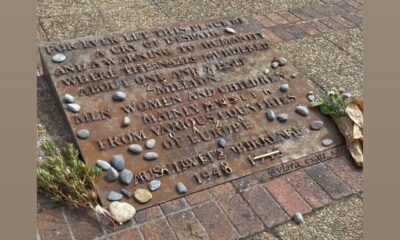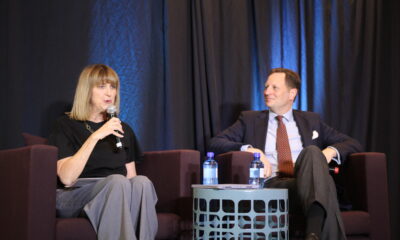
World

Exhibition reveals Germany’s hidden ‘queer’ history
Published
1 year agoon
“Being unseen, unrecognised, invisible to others, is really the most existential form of disrespect,” said German author Carolin Emcke. Emcke was quoted by Dr Mirjam Zadoff, the director of the Munich Documentation Centre for the History of National Socialism, who spoke about the omission of the persecution of lesbian, gay, bisexual, transgender, queer (LGBTQ) people from historical archives, particularly during the Holocaust.
Zadoff said the Nazi regime’s discriminatory laws persisted for many decades after the war, ensuring that “the history of queer life remained untold”. She was speaking at the Johannesburg Holocaust & Genocide Centre on 9 February.
Zadoff was in South Africa to share part of an international exhibition, “To Be Seen. Queer lives 1900-1950” that “narrates the diversity of queer life in Germany at the beginning of the 20th century and its subsequent eradication between 1933 and 1945”.
The exhibition is in partnership with the Johannesburg Holocaust & Genocide Centre and GALA Queer Archive, an organisation set up to preserve South African queer history and amplify LGBTQ voices.
This year’s Holocaust Memorial Day on 27 January 2023 was the first time that the German government officially recognised queer people as victims of the Holocaust, Zadoff said.
Most of what was previously documented about queer people, particularly homosexual men, covered their lives only during and after prosecution. Their own testimony and personal documentation wasn’t properly archived. “Much has disappeared or was deliberately never documented, written down, or visually recorded,” said Zadoff. The exhibition is predominantly composed of items from the personal archives of family and friends of victims, collated by queer people to preserve the memory of those who came before them.
“We have chosen to document what existed before the Nazi regime destroyed it,” said Zadoff. As far back as 1871, the German Empire’s criminal code ruled that men having sex with men or animals were punishable by imprisonment or loss of civil rights. This continued into the Nazi regime, under which gay men and trans women were classified as sexual deviants, along with paedophiles and zoophiles.
“Feminism, gender studies, or queerness were denigrated as a threat to traditional ideas of masculinity,” said Zadoff.
However, in some cases, the stricter the laws, the more the upswing in activism. In the early 20th century, there was an upsurge of queer culture in Germany. The Weimar Republic, which was known for its celebration of artistic freedom, allowed queer people to find self-expression.
“Nearly 200 subcultural venues are documented in the imperial capital between 1919 and 1933,” Zadoff said, including 80 lesbian bars in Berlin alone. There was also dedicated infrastructure for “transvestites” (an outdated term describing cross dressers).
“Magazines would contain references to these meeting places as well as relevant contacts. They risked being banned and labelled as ‘trash texts’, so they would use euphemisms, like finding ‘ideal friendship’ or ‘friendly exchange of ideas’ to refer to lesbian and gay connections,” Zadoff said.
As Germany became harsher towards those it deemed different, there was an alternate emerging scientific interest in gender and sexuality, and the field of sexology became increasingly popular. In fact, some Jewish doctors who were denied jobs in traditional medical fields would work in sexology clinics.
Magnus Hirschfeld was a Jewish physician and “champion of decriminalisation” who founded the Institute of Sexology in 1919. “As a Jew, social democrat, and homosexual activist, he became a target of right-wing extremist and racist forces at an early stage.” He aimed to create a refuge not only where queer people could get necessary medical treatment and counselling, they could also find work.
“With the advancement of sexology, new notions of the body, gender, and intimacy were finding expression in art and culture,” said Zadoff. “Literature, theatre, film, and the visual arts offered an opportunity to question gender stereotypes and create new roles and body images.” Art that emerged from this period provides a framework for what’s perceived today as “queer aesthetics”.
In 1933, when the Nazi party came into power, avant-garde works were denounced as degenerate and confiscated, banned, or destroyed, and only the work of artists who immortalised traditional gender images were permitted, Zadoff said.
Queer communities were widely dismantled, and queer relationships confined to private spaces. “During the first major Nazi raids against homosexuals on 20 October 1934, 145 men were arrested in Munich alone.”
In June 1935, paragraph 175 of the German criminal code was intensified, ruling that acts between men bearing any sort of “sexual suggestion” were punishable. Within Nazi concentration camps, gay men were identified using the infamous pink triangle denoting “sexual deviants”. Throughout the regime, “about 57 000 homosexual men were sentenced to prison, and between 6 000 and 10 000 of them were deported to concentration camps, of whom at least half were murdered”.
“If lesbian women and people who didn’t conform to their gender were denounced, they were threatened with police investigations, house searches, and interrogations,” Zadoff said. Also “if political opposition, social deviance, or racial persecution occurred, they faced internment in a concentration camp”. To avoid torment by the Nazis, many lesbian women would enter “marriages of convenience” with gay men.
One lesbian couple whose story has been preserved is that of Elizabeth (Lilly) Wust and Felice Schragenheim. The two met in 1942, however, Schragenheim was forced to go into hiding as she was Jewish. She eventually moved in with Wust, and the pair drafted and signed their own marriage contract in 1944.
That year, Schragenheim was transported to Theresienstadt concentration camp. “In the hope of helping her beloved, Lilly Wust travelled to Theresienstadt herself in the fall of 1944,” said Zadoff. However, Schragenheim was transferred to Auschwitz soon after.
Wust searched for her for many years after that, however it’s presumed that she was murdered in Bergen-Belsen in March 1945. In an interview in 2001, Wust said, “She was my other half, literally my reflection, my mirror image, and for the first time, I found love aesthetically beautiful, and so tender. I dream that we will meet again – I live in hope.”
Just as antisemitism and racism didn’t cease to exist when the war came to an end, homophobia in German society persisted long after the Holocaust ended. While other concentration camp prisoners were freed, homosexuality was illegal until 1969. This meant that many homosexual men were sent straight from concentration camps to regular prisons.
“Queer history was hardly remembered or archived after 1945. To this day, we know only some of the pioneers of the queer emancipation movement. We know even less about the life of those who were persecuted, driven into exile, murdered, or simply remained invisible,” said Zadoff.










